


Teaching your children all about magnets? Well, this guide should be a great help. Here, you can learn all about:
A magnet is a metal which attracts or repels other materials. A magnet is made from magnetic materials such as iron, nickel, steel, or cobalt. Magnets have two poles, north and south. Magnets have an invisible magnetic field that allows them to attract or repel certain materials.

Your children will learn about magnets in science at KS1 and KS2. You'll find a range of helpful teaching resources on magnets here at Twinkl. For example, this Collection of Magnet Resources for KS2 features a fantastic selection of teaching aids that are informative and simple to use.
How do magnets work? Magnets have two poles. The north pole of a magnet will always attract to the south pole of another magnet. If two north poles or two south poles are put together, they will repel each other. When this happens, the magnets will move away from each other. This happens because of magnetic force.
Teaching your kids how magnets work? This is all about magnetic force and magnetic fields.
Magnetic force is a force that is created by electrons and occurs between electrically charged particles. Applied by magnets onto magnetic objects, this force creates and controls magnetism and electricity.
We cannot actually see forces working - they are invisible to the human eye - however, we can observe their effects on different objects when conducting a forces science experiment.
The area where a magnetic material experiences a magnetic force is called a magnetic field.
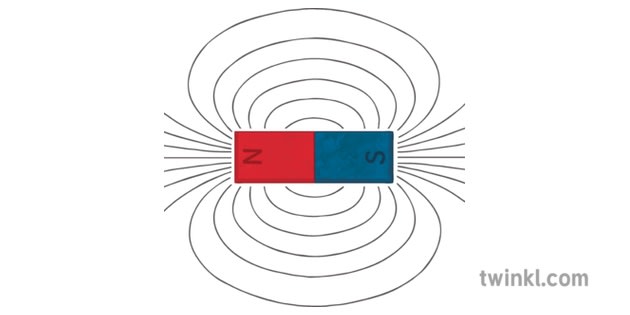 When thinking about the science of magnets and magnetic force, it is a good idea to contextualise it in relation to other types of forces to help children learn about what makes magnetic forces different.
When thinking about the science of magnets and magnetic force, it is a good idea to contextualise it in relation to other types of forces to help children learn about what makes magnetic forces different.
Magnetic forces are likely to be the first type of non-contact force that children are introduced to. We call magnetic forces non-contact simply because, unlike most forces, they can work from a distance and so can push or pull on objects without directly touching them.
To help children's understanding of this key term, it is a good idea to give them an example of a contact force for comparison, such as opening a door.
This ready-made lesson plan has some super practical ideas on how to show as well as tell children this key difference.
For a fun experiment that is in line with the national curriculum for science guidance, why not give children a selection of materials along with a magnet and ask them to test out and then group the objects into magnetic or non-magnetic using our handy, free, Magnetic or Not Magnetic Table?
Once children have learnt about magnet science and magnetic and non-magnetic materials, they can then begin to discover the ways that two magnetic objects can act together:
A magnetic force can either cause two magnetic objects to repel or attract.
When magnets attract each other, they are pulled closer together. When they repel, they are pushed apart.
In order to understand the science behind magnets and magnetism, we must understand whether magnets will attract or repel another magnet. We must also consider the relationships between the magnetic poles.
Magnets have two poles: a north pole and a south pole.
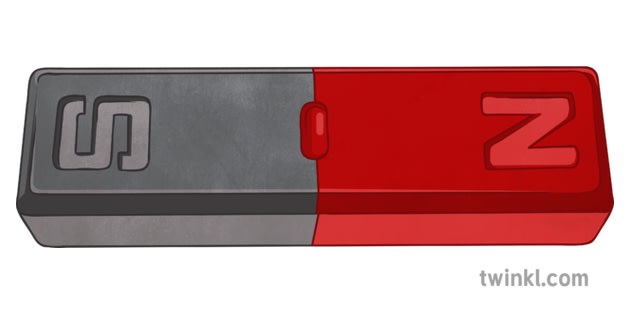 A magnetic field is concentrated at the ends of magnets. These ends are called poles.
A magnetic field is concentrated at the ends of magnets. These ends are called poles.
We use these names because if you hang a magnet from a thread, the magnet's north pole points (almost) towards the north direction.
This is because the Earth's core (its centre) is a large, weak magnet. Your little, strong magnet lines up with Earth's magnetic core, so it points north. That's how a magnetic compass works.
Why do opposites attract? If you hold two magnets the wrong way around, so you have a two south poles facing each other, they push apart or repel. In other words, if you hold two magnets together so that like-poles are close together (two norths or two souths), they repel. It feels like the magnets are surrounded by an invisible rubber layer, pushing them apart. That invisible layer is called a magnetic field.
It's only when you hold unlike poles together (a north and a south) that magnets are attracted to each other. Now, the magnetic field acts like a stretched rubber band, pulling the magnets together.
The magnetic field that surrounds all magnets contains stored-up energy. But there's a way to change the amount of stored-up energy surrounding the magnet. And the way you change it will tell you which way the magnet will move.
Under the national curriculum guidance, children are expected to be able to put this theory into practice by predicting whether two magnets will attract or repel each other depending on which poles are facing.
Here is a picture of magnets repelling
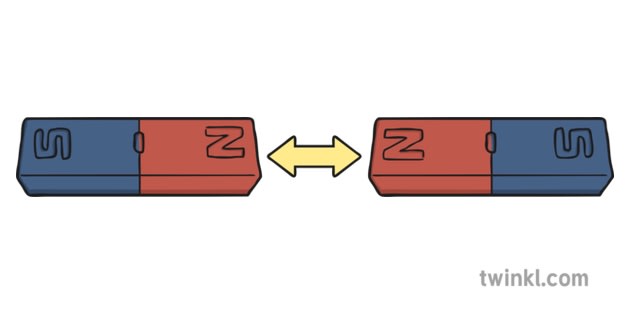
Here is a picture of magnets attracting
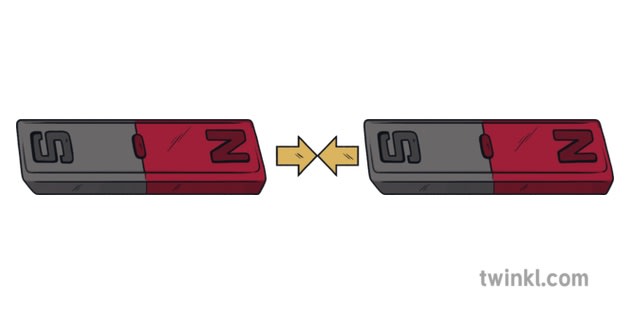
Our teacher-made Attract or Repel Worksheet is an effective way to test children's understanding of this. Or they could even try this first-hand in an experiment. You can also take a look at this informative Magnetic Force PowerPoint.
Remember that only iron, cobalt, and nickel (or alloys containing these metals) are magnetic.
A permanent magnet is one with its own magnetic field. The magnetism cannot be turned on or off, e.g., a bar magnet or a horseshoe magnet.
Magnetic materials are always made from metal. Objects that contain these metals will, therefore, be magnetic. So, if all magnetic materials are made from metal, does that mean that all metals are magnetic? The simple answer is no. whilst many metals are magnetic, there are a wide variety of metals that are not. For example, iron is magnetic, whilst aluminium and copper are not.
Magnetic metals include:
Iron
Cobalt
Nickel
Teaching your kids about magnetic materials? With this Activity Sheet, they'll be tasked with investigating different materials, assessing whether they're magnetic materials or non-magnetic materials.
Your kids can test their knowledge of magnets and magnetic materials with a simple quiz. For example, you could task them with answering the following questions:
What are magnetic materials always made from?
Are all metals magnetic?
Would a silver spoon be magnetic?
As mentioned above, the only magnetic materials are iron, nickel, and cobalt. This means that all other materials are not magnetic. Here's a list of some common non-magnetic materials:
Aluminium
Copper
Gold
Water
Plastic
Wood
Rubber
If you are going to get really technical about what materials are magnetic and what ones aren’t, you must address the fact that the only truly non-magnetic thing is a vacuum. This is because a vacuum has a magnetic permeability of exactly 1 and no material within it that can interact with a magnetic field. Within every other material, regardless of whether it is classed as magnetic or non-magnetic, there is some form of interaction when a magnetic field is applied. This is because every material has a magnetic permeability with a value other than 1.
The materials that are generally thought of as non-magnetic actually just have very weak interactions with magnetic fields. This interaction is often too small to see, but it still occurs. The materials are still having some sort of attraction or repulsion in reaction to a magnetic field being applied. This means that the materials that are typically classed as non-magnetic are actually either paramagnetic, diamagnetic, or antiferromagnetic. Let’s have a quick look at what each of these means:
Paramagnetic Materials: These are metals that have a very weak attraction to magnets. Paramagnetic materials include aluminium, gold, and copper.
Diamagnetic Materials: These are materials that are repelled by a magnetic field. Diamagnetic materials are those that many people generally think of as non-magnetic. Some of these materials include wood, some plastics, and a range of metals including copper, mercury, and gold.
Antiferromagnetic Materials: Within these materials, the magnetic moments of atoms or molecules, typically in relation to the spins of electrons, form a regular pattern with neighbouring spins pointing in opposite directions. This results in a strong magnetic response when a magnetic field is applied.
Every material that exists can be classified into one of 5 magnetic categories. These categories are as follows:
Diamagnetism;
Paramagnetism;
Ferromagnetism;
Ferrimagnetism;
Antiferromagnetism.
Here are some images of non-magnetic materials:
Plastic

Gold

Magnets are divided into three types:
Permanent magnets always retain their magnetism, as they're made from materials that are magnetic, and their electrons don't change direction. Temporary magnets become magnetic when in the presence of a magnetic field, and electromagnets are powered by electricity and can be turned on or off.
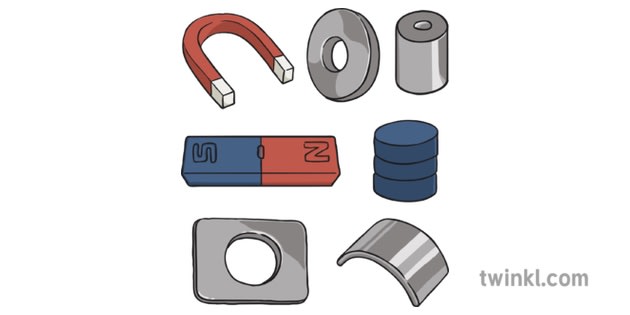
Permanent magnets have a variety of shapes and names. The seven magnets kids will learn all about are: horseshoe magnets, cylindrical magnets, bar magnets, button magnets, ring magnets, square magnets and arc/crescent magnets. These magnets are all different shapes as they are used in different ways.
Within the three main types of magnets, are seven magnets. Each magnet has their own set of characteristics.
Permanent magnets include:
NdFeB magnets are strong, compact magnets that are usually coated in nickel, gold or iron plating.
SmCo is another of the 7 magnets that is strong and maintains its magnetism. These magnets can also withstand high temperatures.
Alnico magnets are made from aluminium, cobalt and nickel.
These strong magnets are the most commonly used permanent magnet and are made from iron oxide and barium.
The next type of magnet is the temporary magnet. Temporary magnets are basically any material that behaves like a magnet when in a magnetic field. These materials are soft metals, for example, paper clips and iron nails can often behave like permanent magnets.
Teaching your children about the 7 types of magnet? Take a look at this handy Lesson Pack.
When teaching children about magnets, it can help them to understand how magnets work and why they're important by learning about how magnets are used in everyday life. Many household items, like electrical items and fridges, have magnets in them. Magnets have been used by humans for thousands of years, today, magnets are used for:
Due to charged electrons, magnets can be affected by electricity. This means that there are many uses for magnets at home. Magnets are often used in electrical items, like computers. Magnets are used in computers to help them store data.
Magnets are also used in the home to preserve food. It is magnets that keep fridge and freezer doors shut, the magnetic force keeps the doors tightly shut to ensure food is preserved.
An MRI is an important scan used to detect problems in the human body. Magnets are used in MRI machines to produce a powerful magnetic field, this forces protons in the human body to align with the field and presents an image of the body to the person operating the machine.
And let's not forget, the Earth itself is one, giant magnet. The Earth projects a large magnetic field from its core.
Teaching your children about uses of magnets in the home and what magnets are used for in everyday life? This Magnets and Materials PowerPoint should be a great help.
Now for the final type of magnet, electromagnets.
A circular magnetic field is produced when a current is passed through a conducting wire. This produces an induced magnet.
Switching off the current causes the magnetism to be lost. The strength of the magnetic field can be increased by increasing the current flowing through the wire. The strength of the magnetic field is stronger closer to the wire. Coiling the wire to form a solenoid will also increase the strength of the magnetic field. The strength of the magnetic field created by a solenoid is strong and uniform throughout.
To increase the strength of the magnetic field around a solenoid, you can...
An electromagnet is a solenoid with an iron core. Electromagnets are induced magnets and can be turned on and off. Electric motors, loudspeakers, electric bells and remotely controlled door
locks all use electromagnets.
Wanting to find out some cool things about magnets? Have a read through these fascinating magnet facts.